- Rugby Toolbox
- Resources & Education
- Learn more
- Articles
- Snook on Coaching
- U8/U10 Draw & Pass and Sidestep
- Ruck & Run Drill
- Playing Philosophy – Ruck & Run Coaching Components
- Playing Philosophy – Spread the Forwards
- Playing Philosophy – A forward behind the ruck
- Playing Philosophy – Ruck & Run
- Playing Philosophy – An idea!
- The Breakdown
- Building Positivity [3]
- Building Positivity [2]
- Building Positivity
- Fitness and Game Related Activities
- Getting the Head Working
- Missiles are Dangerous
- Use of Video
- Winger Attacking Outside First-Five
- Player Profiling
- Selection
- Fitness Away from the Team Session
- Playing Philosophy (Pre season Prep)
- Coaching the Coaches
- The Rugby Coordinator and Pre-Season Preparation
- Why Not Use Tap Penalties More Often?
- Why Kick the Ball Down the Middle of the Field?
- Defending the 5 Metre Lineout Drive
- Scoring from the 5 Metre Lineout
- What are the Kicking Team Aiming to Achieve from Halfway Restart
- Should We Practice Scoring Tries?
- Team Culture
- Looking After Your Players
- Coach Survival Tips
- Under 11/13 – Backline Defence
- Under 11/13 – Ruck Defence
- Under 11/13 – Back Attack
- Under 13 – The Counter Attack
- Under 11/13 – The Maul
- Under 11/13 – Lineouts
- Under 11/13 – Decision Making
- Under 11/13 – Support Play
- Under 11/13 – Dive Pass and More
- Under 11/13 – Drop & Grubber Kick /Highball Catch
- Under 11/13 – Front on Tackling
- Under 11/13 – Contact – Getting Up – The Ruck
- Under 11/13 – The Coaching Session
- Under 8/10 – Using Space
- Under 8/10 – Kicking
- Under 8/10 – Contact and Picking Up the Ball
- U8/U10 Draw & Pass and Sidestep
- Under 8/10 – The Tackle
- Under 8/10 – The Coaching Session
- Under 7 – Test Your Coaching – Support Play
- Tap Pass and Swerve U7
- Ball Familiarisation; Passing & Receiving
- Activities for the Non-Contact Tackle
- Under 7 – The Coaching Session
- Coaching Teenagers – After the Ruck
- Coaching Teenagers – The Practice Session
- Coaching Teenagers – Best Practice
- Coaching Kids – Best Practice
- Plays from a Tap Penalty
- Running Plays from a 5 Man Lineout
- Driving Plays from a 5 Man Lineout
- Strike Plays at the End of the Lineout
- Back Strike Plays at the Lineout
- Wide Strike at the Scrum (2)
- Wide Strike at the Scrum
- Midfield Attack at the Scrum
- No 8 Plays at the Scrum (2)
- No 8 Plays at the Scrum
- The Cut Out Pass
- Skills to Penetrate (2)
- Skills to Penetrate
- Movements to Penetrate
- Patterns to Penetrate
- Contact and Continuity
- Keeping the Ball Alive Out Wide
- Pre Season Support Activities
- Checklist
- Understanding the game
- The Playing Philosophy
- The Lineout
- Overview
- Team Profile
- Start Now!
- Backrow
- Nine and Ten
- Rugby-related Fitness Activities
- The Psychological Edge
- Open Field Play
- Key Performance Indicators
- Improving Team Performance
- Backline Attack Concepts
- Tactics at Phase Play
- Playing Philosophy
- The ‘Stop Focus’
- Kick Attack
- Clearing the 22
- Wide Attack at Phase
- Player Focus
- Scrum Preparation
- Lineout Preparation
- Back Attack Preparation
- Sevens Preparation
- Sevens Kick Offs
- Sevens Scrum and Lineout
- Sevens Attack Patterns
- Sevens Defence
- 7's Selection and Game Planning
- Coaching and Leadership
- How the Game Evolves
- Changing Within the Game
- Learning from the Television.
- Using Tap Penalties Wisely
- Defence Drills
- Defence Drills for Tight Five
- Team Defence and TUB’ing
- Establishing Patterns from the Ruck
- Structured Phase Play
- Structuring Phase Play on the Run
- Coaching Roles
- Structuring a Close in Tackling/Defensive Session
- Coaching in Threes
- Attacking Back Play
- Kick Off Chase
- Wrap Around Back Plays
- Lineout Plans
- Looking and Learning
- Motivating Your Players
- Scrum Attack
- Refocusing the Team
- Monitoring the Progress
- Learning the Game
- Playing to the Laws
- Small is OK
- Decisions After the Tackle
- Improving Your Coaching
- Food for Thought
- More Food for Thought
- Passing & Catching
- How Ireland Nearly Beat the All Blacks
- The Progressive Coach
- Try Something New
- Encouraging Excitement
- The Mental Approach
- Where to Start
- Being the Best You Can Be
- Off the Ball Decisions
- Lineouts Difficult to Master
- Decisions on the Run
- Rucking and Rolling
- A Successful Approach
- Gaining Clarity
- Manipulation vs Physicality
- Beating the Drift
- To Ruck or Not to Ruck
- Stopping the Lineout Drive
- Fine Tuning the Planning
- It's a Running Game
- RugbySmart 2015
- Using the Shoulders
- Loosehead Prop / Tighthead Prop
- Position Specific – Hooker
- Position Specific – Lock
- Position Specific – Blindside Flanker
- Position Specific – Openside Flanker
- Position Specific – No 8
- Position Specific – Halfback
- Position Specific – First Five Eighth
- Position Specific – Second Five Eighth
- Position Specific – Centre Three-quarter
- Position Specific – Wing
- Position Specific – Fullback
U8/U10 Draw & Pass and Sidestep
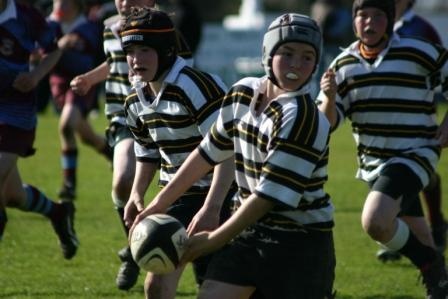
Under 8/10 – Draw & Pass / The Sidestep
Draw and Pass
Continue with the basic pass and catch and running with the ball drills that have been introduced with the Beginners. These will need to be reinforced before the players can understand and execute the draw and pass.
The objective of the draw and pass is to maintain the flow of the game by passing to a teammate who is in a better position to run with the ball. The coach needs to set up these scenarios that demonstrate this to the players so they see the need to make a pass.
Now is the time to combine the running with the ball, making a pass on the run and support play.
Running with the Ball
- Carry the ball in two hands so that the defender is not sure what the attacker is going to do.
- Run as straight as possible at the defender so that they are made to stand still and have their feet planted which makes them easier to beat with a pass or a step.
- Look at the tackler so that you know where they are and what they are doing. They will also be attracted to the runner if that person is looking at them.
- Before starting the run have a quick look to see where your teammate is positioned. Have another look once you have decided the time is right to pass.
Passing on the Run
- When the defender is committed to tackle the player with the ball that player will choose the time to pass.
- They will look at the receiver and swing their arms across their body.
- Use the wrists to propel the ball along with the arms. This will require bent elbows to begin with.
- Follow through with the arms and point to the spot where you want the ball to arrive at chest height in front of the receiver.
- Turn the inside shoulder and thigh and hip slightly to the tackler to get the rotation for the pass and to present hard parts for the tackler to make their tackle.
- Keep the arms and fingers pointed momentarily and continue running forward in the straight line.
Support
- Once the player has made the pass they should support the ball carrier.
- This will require the passer to run hard and wrap around the new ball carrier to receive another pass or to join the attackers. Alternatively, they may stay inside the ball carrier and call for an inside pass if there is a space available.
- This is crucial to continue the momentum of the attack.
ACTIVITIES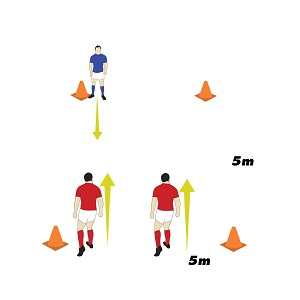
1 – 2 v 1
Set up a small grid with 2 attackers along one line and the defender on the opposite line marking up on the ball carrier.
The ball carrier and defender move forward towards each other and at the appropriate time the ball carrier will pass to his support player. The pass must be timed so that the defender does not have time to run over and tackle the support player. This requires the ball carrier to commit the tackler by running straight at them and keeping them square and the support player timing their run so that they accelerate and catch the pass running at nearly full speed.
The attack should count how many tries they score from 6 attempts. Swap around.
Set up activities with 2 v 1 situations. In a 10 x 10 grid roll the ball towards the 2 attackers. The player who picks the ball up must run at the defender and pass to his support player to score. Remind the players, run at the defender to stop them and pass away from the defender when they are committed to tackling 'you'.
2- 2 v 1 + 1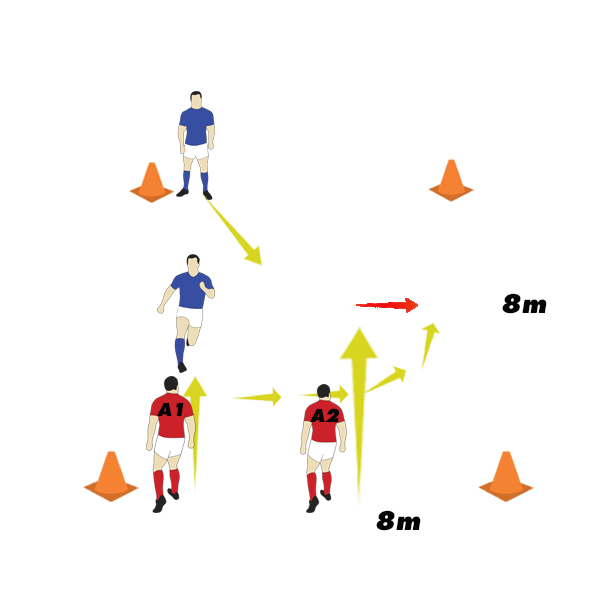
Mark out a larger grid. 8 x 8 metres. 2 attackers are along one side of the grid. 1 defender is opposing the ball carrier 4 metres away and another defender is behind the original defender on the corner of the grid opposing the ball carrier.
The scenario is two situations of 2 v 1. The ball carrier runs forward as does the original defender (as in the first drill) As the ball carrier passes to their support player the second defender leaves their corner to tackle the new ball carrier.
The new ball carrier heads towards the new defender and as they commit them to the tackle they pass to the original ball carrier who is on their outside after having run a support position.
See which pair can get the most tries from 6 attempts.
3- 3 v 2
As the players improve their skill level introduce a 3 v 2 in a larger grid.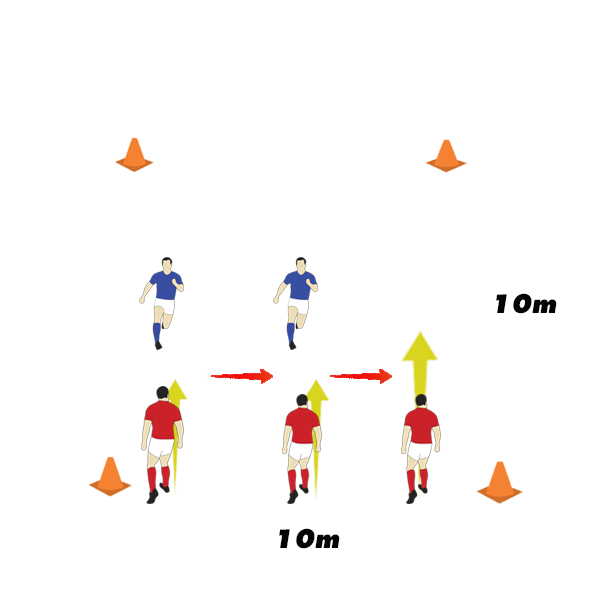
Remember to coach the key points as you play the activity.
Running straight with the ball in two hands is the key. Make sure attacker 2 receives the ball with a bit of depth so that they can run straight as well and is not under too much pressure.
The third attacker must hold his depth and run at pace on to the ball.
The attackers must pass and support so that one is on the outside of the ball carrier and one is behind them.
For a start make sure the tacklers just stay on the player they are marking at the beginning. Once they get better on the attack then the defenders can change who they mark up on. This will require the ball carrier to look forward and decide on what to do – run; pass outside; pass inside.
The Side-Step
The swerve has been practiced with the Beginners (Under 7’s) which may well have been a sidestep for some. The idea is to get the players practicing what they are good at which may be a swerve, a side-step or a goose-step.
Similar activities can be used to practice these skills but it helps if the coach knows what they are looking for and can improve the skill.
The swerve will be when the player runs at the inside shoulder of the defender and at the appropriate time they will change pace and angle with their inside leg swivelling across their outside leg and accelerating in to the outside space.
The sidestep can take place in a more confined area with the ball carrier aiming for one shoulder on the defender with a step to that side and a shoulder feint to the same side. They will set this up with a few short steps to get in to balance.
They will then step back in the other direction off the foot which they had just planted. Take a wide step back to where you started and accelerate forward. This requires the player to step laterally before going forward. It is that stop-start movement that is the key to beating the tackler.
The kids will love using this skill. Keep the ball in two hands until after the side-step. Then place it under the far arm from the tackler.
ACTIVITIES
1- Cones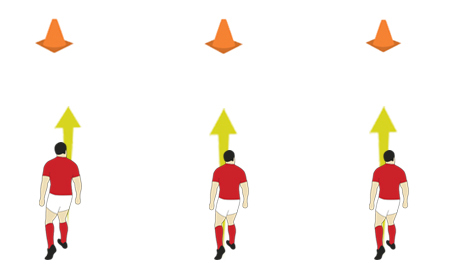
Set up cones so that the player a) runs towards a cone and gets in to balance with short steps carrying the ball in two hands and looking forward. Arrive at the cone up on the toes with feet moving quickly and feet about shoulder width apart b) take a step out to a cone on the right or left and move the ball in that direction in two hands at the same time as the upper body feints in that direction c) push hard off the leg you have landed on directly back in the direction you came, this time taking a larger step. The player should have shifted to a point further across from the starting point. Have another cone there. d) accelerate forward on the outside leg transferring the ball across to the outside of the body.
2 – 1 v 1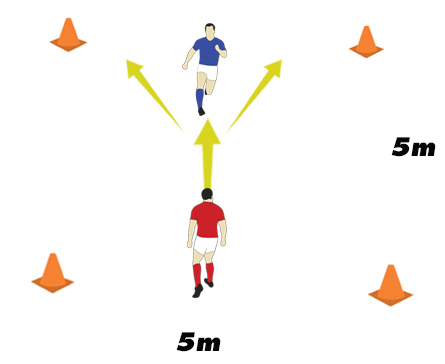
a) In a small grid introduce the skill and get the players to practice it in 1 v 1 situations.
In the first instance the defender stands in the middle of the grid and the attacker can step either side of a static defender.
b) When the players understand the concept start them 5 metres apart and ask the attacker how many tries they can score by using the side-step. Try 5 turns each.
c) Finally roll a ball to the attacker who must pick it up and step the defender coming towards them.
3- 2 v 1 + 1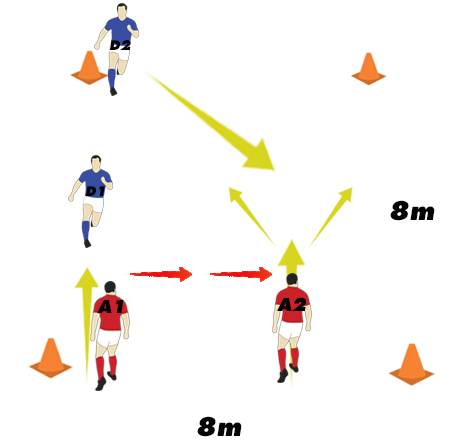
Using the above activity ask the second receiver to step the second defender.
They must slow them by running at them, then step and accelerate when they have slowed.
A toughie but a lot of fun.